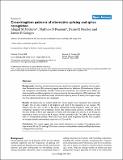Cross-kingdom patterns of alternative splicing and splice recognition
Author(s)
McGuire, Abigail Manson; Pearson, Matthew D.; Neafsey, Daniel E.; Galagan, James E.
Downloadgb-2008-9-3-r50.pdf (508.2Kb)
PUBLISHER_CC
Publisher with Creative Commons License
Creative Commons Attribution
Terms of use
Metadata
Show full item recordAbstract
Background: Variations in transcript splicing can reveal how eukaryotes recognize intronic splice sites. Retained introns (RIs) commonly appear when the intron definition (ID) mechanism of splice site recognition inconsistently identifies intron-exon boundaries, and cassette exons (CEs) are often caused by variable recognition of splice junctions by the exon definition (ED) mechanism. We have performed a comprehensive survey of alternative splicing across 42 eukaryotes to gain insight into how spliceosomal introns are recognized. Results: All eukaryotes we studied exhibit RIs, which appear more frequently than previously thought. CEs are also present in all kingdoms and most of the organisms in our analysis. We observe that the ratio of CEs to RIs varies substantially among kingdoms, while the ratio of competing 3' acceptor and competing 5' donor sites remains nearly constant. In addition, we find the ratio of CEs to RIs in each organism correlates with the length of its introns. In all 14 fungi we examined, as well as in most of the 9 protists, RIs far outnumber CEs. This differs from the trend seen in 13 multicellular animals, where CEs occur much more frequently than RIs. The six plants we analyzed exhibit intermediate proportions of CEs and RIs. Conclusion Our results suggest that most extant eukaryotes are capable of recognizing splice sites via both ID and ED, although ED is most common in multicellular animals and ID predominates in fungi and most protists.
Date issued
2008-03Department
Broad Institute of MIT and HarvardJournal
Genome Biology
Publisher
BioMed Central Ltd
Citation
Genome Biology. 2008 Mar 05;9(3):R50
Version: Final published version
ISSN
1474-760X
1474-7596